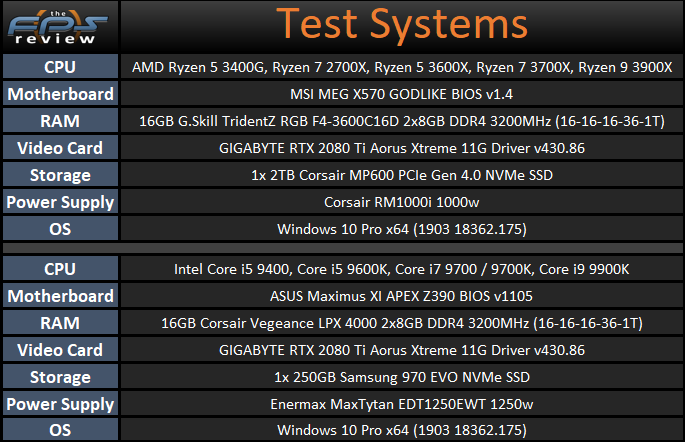Performance Testing and Methodology
For CPU and motherboard testing, we used the following configurations:

Due to the scheduler improvements to Windows 10 build 1903, we decided to use build 1903 for all system testing. While many of the applications here have been used before in our motherboard reviews, even with the same configurations, the numbers are not comparable. Those were all done on builds 1803 and 1809 using the drivers that were current then. All systems were freshly formatted, and all the latest drivers and OS patches were used. All of the systems were updated to their latest BIOS revisions. Finally, for the Intel system, I did install the CPU microcode updates relevant to that CPU. It’s important to note that build 1903 does contain improved mitigations for several security flaws on Intel processors. However, I did not go out of my way to download any additional or optional mitigation patches. Hyperthreading also remained enabled for all testing.
We also followed AMD’s recommendations for using CPPC2 (where applicable) which is enabled by using AMD’s balanced power plan. Essentially, we created a “best case” scenario for each system outside of the hardware configurations. For the hardware, it was impossible to use the same memory modules on all of the test systems due to the nature of memory compatibility on different motherboards. That said, we were able to use common frequencies and keep the timings relatively close for the most part. The primary timings for example were all kept the same, though sub-timings may differ between manufacturers of specific modules. All RAM was configured to run at DDR4 3200MHz using the following timings: 16-16-16-36-1T@1.35v.
The “stock” settings for CPU’s are their automatic or default base/boost clocks. The boost clocks are shown in the graphs for reference. Overclocked values are shown with a fixed clock speed value with no boost clock range given where applicable.
One final note is that I’ve left the results for AMD and Intel’s higher-end offerings in the tables for reference, but it isn’t really our intention to compare those processors to the much less expensive Ryzen 5 3400G and Core i5 9400 CPU’s specifically. I think it’s important to note where less expensive product may stack up in a given product line, but people with a $500 budget for a CPU are probably not cross-shopping sub-$200 CPU’s.
